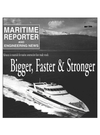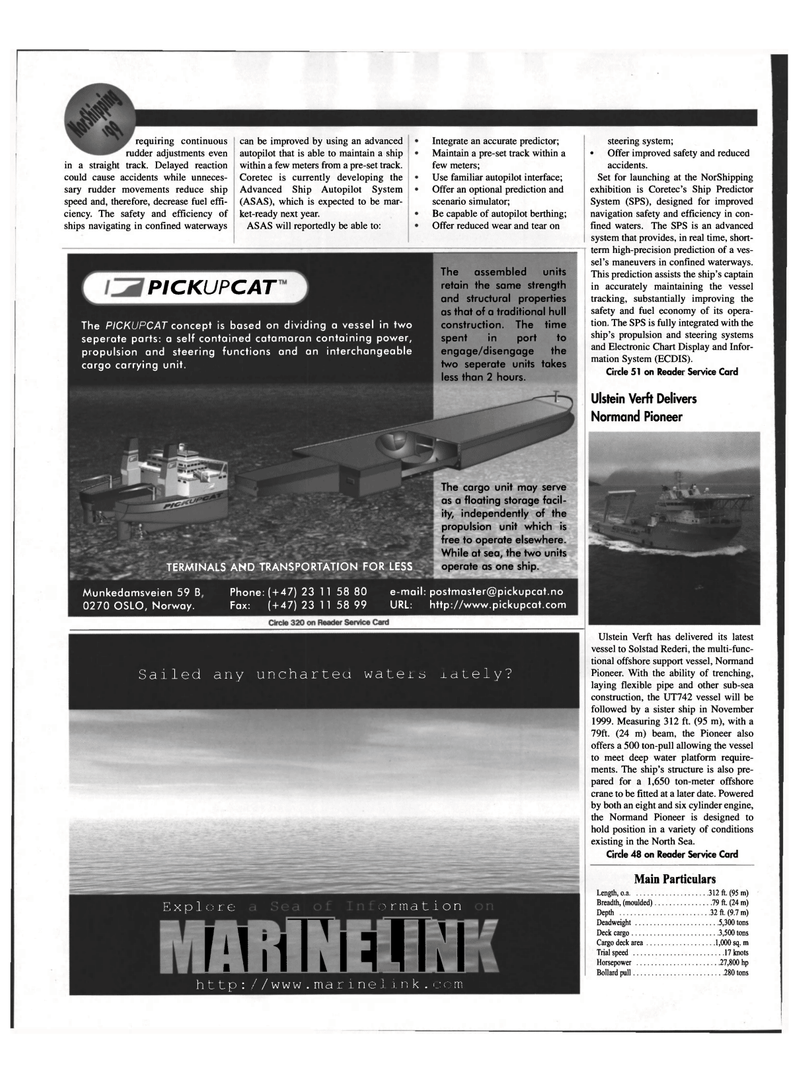
Page 46: of Maritime Reporter Magazine (May 1999)
Read this page in Pdf, Flash or Html5 edition of May 1999 Maritime Reporter Magazine
requiring continuous rudder adjustments even in a straight track. Delayed reaction could cause accidents while unneces- sary rudder movements reduce ship speed and, therefore, decrease fuel effi- ciency. The safety and efficiency of ships navigating in confined waterways can be improved by using an advanced autopilot that is able to maintain a ship within a few meters from a pre-set track.
Coretec is currently developing the
Advanced Ship Autopilot System (ASAS), which is expected to be mar- ket-ready next year.
ASAS will reportedly be able to:
Integrate an accurate predictor;
Maintain a pre-set track within a few meters;
Use familiar autopilot interface;
Offer an optional prediction and scenario simulator;
Be capable of autopilot berthing;
Offer reduced wear and tear on
Sailed any uncharted waters lately?
Explore ormation
MM TNTTM http://www.marinelink.com steering system; • Offer improved safety and reduced accidents.
Set for launching at the NorShipping exhibition is Coretec's Ship Predictor
System (SPS), designed for improved navigation safety and efficiency in con- fined waters. The SPS is an advanced system that provides, in real time, short- term high-precision prediction of a ves- sel's maneuvers in confined waterways.
This prediction assists the ship's captain in accurately maintaining the vessel tracking, substantially improving the safety and fuel economy of its opera- tion. The SPS is fully integrated with the ship's propulsion and steering systems and Electronic Chart Display and Infor- mation System (ECDIS).
Circle 51 on Reader Service Card
Ulstein Verft Delivers
Normand Pioneer
Ulstein Verft has delivered its latest vessel to Solstad Rederi, the multi-func- tional offshore support vessel, Normand
Pioneer. With the ability of trenching, laying flexible pipe and other sub-sea construction, the UT742 vessel will be followed by a sister ship in November 1999. Measuring 312 ft. (95 m), with a 79ft. (24 m) beam, the Pioneer also offers a 500 ton-pull allowing the vessel to meet deep water platform require- ments. The ship's structure is also pre- pared for a 1,650 ton-meter offshore crane to be fitted at a later date. Powered by both an eight and six cylinder engine, the Normand Pioneer is designed to hold position in a variety of conditions existing in the North Sea.
Circle 48 on Reader Service Card
Main Particulars
Length, o.a 312 ft. (95 m)
Breadth, (moulded) 79 ft. (24 m)
Depth 32 ft. (9.7 m)
Deadweight 5,300 tons
Deck cargo 3,500 tons
Cargo deck area 1,000 sq. m
Trial speed 17 knots
Horsepower 27,800 hp
Bollard pull 280 tons
The PICKUPCAT concept is based on dividing a vessel in two seperate parts: a self contained catamaran containing power, propulsion and steering functions and an interchangeable cargo carrying unit.
TERMINALS AND TRANSPORTATION FOR LESS e-mail: [email protected]
URL: http://www.pickupcat.com
Phone: ( + 47) 23 1 1 58 80
Fax: ( + 47)23 11 58 99
Munkedamsveien 59 B 0270 OSLO, Norway.
The assembled units retain the same strength and structural properties as that of a traditional hull construction. The time spent in port to engage/disengage the two seperate units takes less than 2 hours.
PICKUPCAT
The cargo unit may serve as a floating storage facil- ity, independently of the propulsion unit which is free to operate elsewhere.
While at sea, the two units operate as one ship.

 45
45

 47
47
